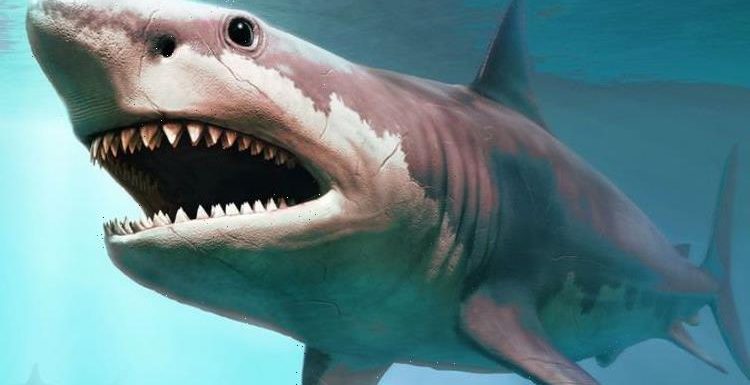
Demon shark ‘bigger than Megalodon’ could exist says expert
We use your sign-up to provide content in ways you’ve consented to and to improve our understanding of you. This may include adverts from us and 3rd parties based on our understanding. You can unsubscribe at any time. More info
Evidence of this prehistoric bloodbath emerged this week after scientists analysed the tooth of a sperm whale date to between 2.3 and 23 million years ago. The 4.5-inch-long (11.6cm) tooth is all that remains of the whale, but a series of grooves gouged into its surface paints a vivid picture of the beast’s demise. According to a study published in the journal Acta Palaeontologica Polonica, the whale likely met its demise in the jaws of the fearsome Otodus – some of the biggest sharks to ever roam the deep seas.
Stephen Godfrey, a palaeontologist at the Calvert Marine Museum and lead researcher, told Live Science: “It would seem that these giant sharks were preying on whatever they wanted to, and no marine animal was safe from attacks from these giant sharks.”
The Megalodon is widely regarded as the largest shark that has ever lived.
Estimates suggest the ancient monster grew between 49ft and 59ft (15m and 18m) in length and sported dagger-like teeth up to seven inches long (18cm).
Experts at the Natural History Museum in London have placed the shark’s lifespan between about 20 and 3.6 million years ago.


Studies suggest Megalodons feasted on their siblings while infants, helping them maintain their enormous growth spurts.
Even more terrifying, recent breakthroughs indicate the Megalodon may have been even larger than assumed.
According to the new study, scientists have identified prominent marks measuring 11.5mm and 23.5mm in length, respectively, on the sperm whale’s tooth.
The placement of the marks indicates a vicious attack to the head “with the goal of inflicting a mortal wound”.
The megalodon clamped down on the whale’s head, cutting through the jaw.
'Megalodon 100 tonne shark' filmed in Mariana Trench
The whale itself would have only measured about 13ft (four metres), compared to its killer measuring up to 60ft nowadays.
The word Megalodon, after all, means “large tooth”.
The marks suggest the whale was killed by a hungry megalodon, or its ancestor, the equally terrifying Otodus chubutensis.
Dr Godfrey said: “None of the other fossil sharks known from the phosphate mine have teeth large enough and serrations even enough to have left these bite traces on the sperm whale tooth.”
Otodus chubutensis, which means “ear-shaped tooth of Chubut”, roamed the oceans between 28 and five million years ago during the Oligocene, Miocene, and Pliocene periods.


These ancient beasts would have feasted on whales, large fish and other sharks, using their serrated teeth to shred their hapless victims.
Their meals would have consisted of animals ranging in size from dolphins to humpback whales.
The Natural History Museum’s Emma Bernard explained: “If you are that big you need to eat a lot of food, so large prey is required.”
Although the scientists have been unable to specify when exactly the shark attack occurred, it would have taken places along the coasts of what is now North Carolina.
According to Dr Godfrey, these coastal waters were relatively shallow and teeming with sea life.
Unlike the dinosaurs, whose skeletons have been preserved in the fossil record, Megalodons and other sharks are largely absent.
That is because their bones are made of cartilage, which does not get preserved over millions of years.
Instead, everything we know about this monster of the deep comes from their bony jaws and teeth that have survived in the rock.
It is estimated the Megalodon could open its impressive jaws some 8.8ft by 11.1ft wide (2.7m by 3.4m).
Source: Read Full Article